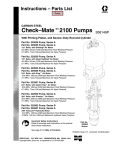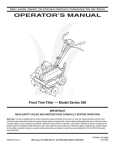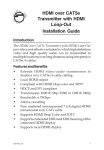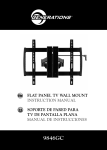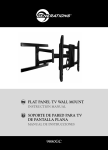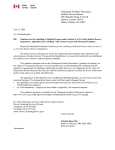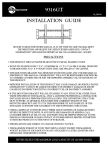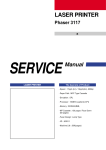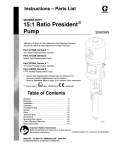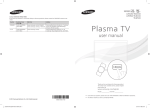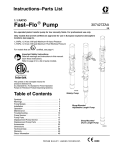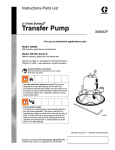Download Graco 308150M User's Manual
Transcript
Instructions – Parts List Parts STAINLESS STEEL Check–Matet 2100 Pump 308150M A piston priming pump with severe–duty rod and cylinder for use with high viscosity materials. Part No. 222903 Pump, Series A, 12:1 Ratio, with Quiet Bulldog Air Motor 8.3 MPa, 83 bar (1200 psi) Maximum Fluid Working Pressure 0.7 MPa, 7 bar (100 psi) Maximum Air Input Pressure Part No. 222836 Pump, Series B, 24:1 Ratio, with King Air Motor 16.6 MPa, 166 bar (2400 psi) Maximum Fluid Working Pressure 0.7 MPa, 7 bar (100 psi) Maximum Air Input Pressure Part No. 222905 Pump, Series B, 24:1 Ratio, with Quiet King Air Motor 16.6 MPa, 166 bar (2400 psi) Maximum Fluid Working Pressure 0.7 MPa, 7 bar (100 psi) Maximum Air Input Pressure Important Safety Instructions. Read all warnings and instructions in this manual. Save these instructions. Part No. 222836 Shown See page 2 for Table of Contents. 0913A GRACO INC.ąP.O. BOX 1441ąMINNEAPOLIS, MNą55440-1441 Copyright 1992, Graco Inc. is registered to I.S. EN ISO 9001 Table of Contents Warnings . . . . . . . . . . . . . . . . . . . . . . . . . . . . . . . . . . . . . . 3 Installation . . . . . . . . . . . . . . . . . . . . . . . . . . . . . . . . . . . . 6 Operation . . . . . . . . . . . . . . . . . . . . . . . . . . . . . . . . . . . . . 9 Service Troubleshooting Chart . . . . . . . . . . . . . . . . . . . . . . . 11 Required Tools . . . . . . . . . . . . . . . . . . . . . . . . . . . . . 12 Disconnecting the Displacement Pump . . . . . . . . 12 Reconnecting the Displacement Pump . . . . . . . . 14 Displacement Pump Service . . . . . . . . . . . . . . . . . 15 2 308150 Parts Drawings and Lists Pump Assemblies . . . . . . . . . . . . . . . . . . . . . . . . . . Displacement Pump . . . . . . . . . . . . . . . . . . . . . . . . Technical Data and Performance Charts . . . . . . . . . . Dimensions . . . . . . . . . . . . . . . . . . . . . . . . . . . . . . . . . . . Mounting Hole Layout . . . . . . . . . . . . . . . . . . . . . . . . . . Warranty . . . . . . . . . . . . . . . . . . . . . . . . . . . . . . . . . . . . . Graco Phone Number . . . . . . . . . . . . . . . . . . . . . . . . . . 21 24 26 32 33 34 34 Symbols Warning Symbol Caution Symbol WARNING CAUTION This symbol alerts you to the possibility of serious injury or death if you do not follow the instructions. This symbol alerts you to the possibility of damage to or destruction of equipment if you do not follow the instructions. WARNING EQUIPMENT MISUSE HAZARD Equipment misuse can cause the equipment to rupture or malfunction and result in serious injury. INSTRUCTIONS This equipment is for professional use only. Read all instruction manuals, tags, and labels before operating the equipment. Use the equipment only for its intended purpose. If you are uncertain about usage, call your Graco distributor. Do not alter or modify this equipment. Use only genuine Graco parts and accessories. Check equipment daily. Repair or replace worn or damaged parts immediately. Do not exceed the maximum working pressure of the lowest rated system component. Refer to the Technical Data on pages 26–31 for the maximum working pressure of this equipment. Use fluids and solvents which are compatible with the equipment wetted parts. Refer to the Technical Data section of all equipment manuals. Read the fluid and solvent manufacturer’s warnings. Do not use hoses to pull equipment. Route hoses away from traffic areas, sharp edges, moving parts, and hot surfaces. Do not expose Graco hoses to temperatures above 82C (180F) or below –40C (–40F). Wear hearing protection when operating this equipment. Do not lift pressurized equipment. Comply with all applicable local, state, and national fire, electrical, and safety regulations. 308150 3 WARNING SKIN INJECTION HAZARD Spray from the gun/valve, hose leaks, or ruptured components can inject fluid into your body and cause extremely serious injury, including the need for amputation. Fluid splashed in the eyes or on the skin can also cause serious injury. Fluid injected into the skin might look like just a cut, but it is a serious injury. Get immediate surgical treatment. Do not point the gun/valve at anyone or at any part of the body. Do not put your hand or fingers over the spray tip/nozzle. Do not stop or deflect leaks with your hand, body, glove or rag. Do not “blow back” fluid; this is not an air spray system. Always have the tip guard and the trigger guard on the gun/valve when spraying. Be sure the gun/valve trigger safety operates before spraying. Lock the gun/valve trigger safety when you stop spraying. Follow the Pressure Relief Procedure on page 9 whenever you: are instructed to relieve pressure; stop spraying; clean, check, or service the equipment; and install or clean the spray tip/ nozzle. Tighten all fluid connections before operating the equipment. Check the hoses, tubes, and couplings daily. Replace worn, damaged, or loose parts immediately. Permanently coupled hoses cannot be repaired; replace the entire hose. Use only Graco approved hoses. Do not remove any spring guard that is used to help protect the hose from rupture caused by kinks or bends near the couplings. MOVING PARTS HAZARD Moving parts, such as the air motor piston, can pinch or amputate your fingers. Keep clear of all moving parts when starting or operating the pump. Before servicing the equipment, follow the Pressure Relief Procedure on page 9 to prevent the equipment from starting unexpectedly. 4 308150 WARNING FIRE AND EXPLOSION HAZARD Improper grounding, poor ventilation, open flames or sparks can cause a hazardous condition and result in a fire or explosion and serious injury. Ground the equipment and the object being sprayed. Refer to Grounding on page 6. If there is any static sparking or you feel an electric shock while using this equipment, stop spraying immediately. Do not use the equipment until you identify and correct the problem. Provide fresh air ventilation to avoid the buildup of flammable fumes from solvents or the fluid being sprayed. Keep the spray area free of debris, including solvent, rags, and gasoline. Electrically disconnect all equipment in the spray area. Extinguish all open flames or pilot lights in the spray area. Do not smoke in the spray area. Do not turn on or off any light switch in the spray area while operating or if fumes are present. Do not operate a gasoline engine in the spray area. TOXIC FLUID HAZARD Hazardous fluid or toxic fumes can cause serious injury or death if splashed in the eyes or on the skin, inhaled, or swallowed. Know the specific hazards of the fluid you are using. Store hazardous fluid in an approved container. Dispose of hazardous fluid according to all local, state and national guidelines. Always wear protective eyewear, gloves, clothing and respirator as recommended by the fluid and solvent manufacturer. 308150 5 Installation 7. Object being sprayed: according to your local code. Grounding WARNING FIRE AND EXPLOSION HAZARD Before operating the pump, ground the system as explained below. Also read the section FIRE AND EXPLOSION HAZARD on page 5. 1. King Pumps: use a ground wire and clamp. See Fig. 1. Remove the ground screw (Z) and insert through eye of ring terminal at the end of ground wire (Y). Fasten ground screw back onto pump and tighten securely. Connect the other end of the wire to a true earth ground. Order Part No. 222011 Ground Wire and Clamp. 8. All solvent pails used when flushing, according to your local code. Use only metal pails, which are conductive, placed on a grounded surface. Do not place the pail on a nonconductive surface, such as paper or cardboard, which interrupts the grounding continuity. 9. To maintain grounding continuity when flushing or relieving pressure, always hold a metal part of the spray gun/dispensing valve firmly to the side of a grounded metal pail, then trigger the gun/valve. Z All Other Pumps: use a ground wire and clamp. See Fig. 2. Loosen the grounding lug locknut (W) and washer (X). Insert one end of a 1.5 mm (12 ga) minimum ground wire (Y) into the slot in lug (Z) and tighten the locknut securely. Connect the other end of the wire to a true earth ground. Order Part No. 237569 Ground Wire and Clamp. Y TI1052 Fig. 1 2. Air hoses: use only electrically conductive hoses. W 3. Fluid hoses: use only electrically conductive fluid hoses. X 4. Air compressor: follow manufacturer’s recommendations. Y Z 5. Spray gun/dispensing valve: grounding is obtained through connection to a properly grounded fluid hose and pump. 6. Fluid supply container: according to your local code. 6 308150 Fig. 2 0864 Installation NOTE: Reference numbers and letters in parentheses in the text refer to the callouts in the figures and the parts drawings. The Typical Installation shown in Fig. 3 is only a guide for selecting and installing system components and accessories. Contact your Graco distributor for assistance in designing a system to suit your particular needs. Accessories are available from your Graco distributor. If you supply your own accessories, be sure they are adequately sized and pressure-rated to meet the system’s requirements. KEY A B C D E F G H J K L M N P R S T Y Pump 200 Liter (55 Gallon) Air-Powered Ram Pump Runaway Valve Air Line Lubricator Bleed-Type Master Air Valve (required, for pump) Pump Air Regulator Air Manifold Electrically Conductive Air Supply Hose Air Line Filter Bleed-Type Master Air Valve (for accessories) Fluid Regulator Fluid Drain Valve (required) Electrically Conductive Fluid Supply Hose Fluid Shutoff Valve Gun/Valve Swivel Airless Spray Gun or Dispensing Valve Ram Air Regulator Ground Wire (required, see page 6 for installation instructions) FLUID HEADER PIPE (3 in. Diameter) J Y K MAIN AIR LINE D B E A F C L P L P T H G S R M M N N M S R 01177A Fig. 3 308150 7 Installation SYSTEM ACCESSORIES WARNING A bleed-type master air valve (E) and a fluid drain valve (M) are required in your system. These accessories help reduce the risk of serious injury, including fluid injection and splashing of fluid in the eyes or on the skin, and injury from moving parts if you are adjusting or repairing the pump. An air regulator (F) controls pump speed and outlet pressure by adjusting the air pressure to the pump. Locate the regulator close to the pump, but upstream from the bleed-type master air valve. The bleed-type master air valve relieves air trapped between this valve and the pump after the air is shut off. Trapped air can cause the pump to cycle unexpectedly. Locate the valve close to the pump. A pump runaway valve (C) senses when the pump is running too fast and automatically shuts off the air to the motor. A pump which runs too fast can be seriously damaged. The fluid drain valve assists in relieving fluid pressure in the displacement pump, hose, and gun. Triggering the gun to relieve pressure may not be sufficient. An air manifold (G) has a swivel air inlet. It mounts to a ram, and has ports for connecting lines to air accessories, such as the ram air regulator (T). Air and Fluid Hoses Be sure all air hoses (H) and fluid hoses (N) are properly sized and pressure-rated for your system. Use only electrically conductive hoses. Fluid hoses must have spring guards on both ends. Mounting Accessories WARNING For Model 222941 Premier Pump, do not lift the pump by the lift ring when the total weight exceeds 550 lb (250 kg). Mount the pump (A) to suit the type of installation planned. Fig. 3 on page 7 illustrates a ram-mounted pump in a multi-gun header system. Pump dimensions and the mounting hole layout are shown on pages 32 and 33. If you are mounting the pump on a ram, refer to the separate ram manual for installation and operation instructions. Air Line Accessories Install the following accessories in the order shown in Fig. 3, using adapters as necessary: An air line lubricator (D) provides automatic air motor lubrication. 8 A bleed-type master air valve (E) is required in your system to relieve air trapped between it and the air motor when the valve is closed (see the WARNING above). Be sure the bleed valve is easily accessible from the pump, and is located downstream from the air regulator. 308150 An air line filter (J) removes harmful dirt and moisture from the compressed air supply. A second bleed-type air valve (K) isolates the air line accessories for servicing. Locate upstream from all other air line accessories. Fluid Line Accessories Install the following accessories in the positions shown in Fig. 3, using adapters as necessary: Install a fluid shutoff valve (P) at each gun drop, to isolate the gun and fluid accessories for servicing. Install a fluid drain valve (M) near the pump fluid outlet, and at each gun station. The drain valves are required in your system to relieve fluid pressure in the displacement pump, hose and gun (see the WARNING at left). Drain valves at the gun stations may be mounted in the base of a fluid regulator (L), using an adapter. A fluid regulator (L) controls fluid pressure to the gun/valve, and dampens pressure surges. A gun or valve (S) dispenses the fluid. The gun shown in Fig. 3 is a high pressure dispensing gun for highly viscous fluids. A gun swivel (R) allows freer gun movement. Operation Pressure Relief Procedure WARNING INJECTION HAZARD Fluid under high pressure can be injected through the skin and cause serious injury. To reduce the risk of an injury from injection, splashing fluid, or moving parts, follow the Pressure Relief Procedure whenever you: are instructed to relieve the pressure, stop spraying/dispensing, check or service any of the system equipment, or install or clean the spray tip/nozzle. 1. Lock the gun/valve trigger safety. The pump is tested with lightweight oil, which is left in to protect the pump parts. If the fluid you are using may be contaminated by the oil, flush it out with a compatible solvent before using the pump. WARNING For your safety, read the warning section FIRE AND EXPLOSION HAZARD on page 5 before flushing, and follow all the recommendations given there. Starting and Adjusting the Pump Supply fluid to the pump, per the requirements of your system. 2. Shut off the air supply to the pump. 3. In air-powered systems, close the bleed-type master air valve (required in your system). 4. Unlock the gun/valve trigger safety. 5. Hold a metal part of the gun/valve firmly to the side of a grounded metal pail, and trigger the gun/valve to relieve pressure. 6. Lock the gun/valve trigger safety. 7. Open the drain valve (required in your system) and/or the pump bleeder valve, having a container ready to catch the drainage. 8. Leave the drain valve open until you are ready to spray/dispense again. If you suspect that the spray tip/nozzle or hose is completely clogged, or that pressure has not been fully relieved after following the steps above, very slowly loosen the tip guard retaining nut, nozzle, or hose end coupling and relieve pressure gradually, then loosen completely. Now clear the tip/nozzle or hose. Refer to Fig. 3 on page 7. Be sure the air regulator (F) is closed. Then open the pump’s bleed-type master air valve (E). Hold a metal part of the spray gun/dispensing valve (S) firmly to the side of a grounded metal pail and hold the trigger open. Now slowly open the air regulator until the pump starts. Cycle the pump slowly until all the air is pushed out and the pump and hoses are fully primed. Release the spray gun/dispensing valve trigger and engage the safety latch. The pump should stall against pressure when the trigger is released. If the pump fails to prime properly, open the bleeder valve (35) slightly. Use the bleed hole on the underside of the valve body (34) as a priming valve until the fluid appears at the hole. See Fig. 4. Close the plug (35). NOTE: When changing fluid containers with the hose and gun already primed, open the bleeder valve plug (35), to assist in priming the pump and venting air before it enters the hose. Close the bleeder valve plug when all air has been eliminated. Packing Nut/Wet-Cup Fill the packing nut/wet-cup (2) 1/3 full with Graco Throat Seal Liquid (TSL) or compatible solvent. See Fig. 4. Using the supplied wrench (104), adjust the packing nut weekly so it is just snug; do not overtighten. Follow the Pressure Relief Procedure above before adjusting the packing nut. WARNING To reduce the risk of fluid injection, do not use your hand or fingers to cover the bleed hole when priming the pump. 308150 9 Operation With the pump and lines primed, and with adequate air pressure and volume supplied, the pump will start and stop as the gun/valve is opened and closed. In a circulating system, the pump will speed up or slow down on demand, until the air supply is shut off. 1 Bleed hole must face down. Use the air regulator (F) to control the pump speed and the fluid pressure. Always use the lowest air pressure necessary to get the desired results. Higher pressures cause premature tip/nozzle and pump wear. WARNING To reduce the risk of overpressurizing your system, which could result in component rupture and cause serious injury, never exceed the specified maximum incoming air pressure to the pump (see the Technical Data on pages 26–31). Never allow the pump to run dry of the fluid being pumped. A dry pump will quickly accelerate to a high speed, possibly damaging itself. A pump runaway valve (C), which shuts off the air supply to the pump if the pump accelerates beyond the pre-set speed, is available. See Fig. 3 on page 7. If your pump accelerates quickly, or is running too fast, stop it immediately and check the fluid supply. If the supply container is empty and air has been pumped into the lines, refill the container and prime the pump and the lines with fluid, or flush and leave it filled with a compatible solvent. Be sure to eliminate all air from the fluid system. 2 34, 35 1 104 Shutdown and Care of the Pump WARNING To reduce the risk of serious injury whenever you are instructed to relieve pressure, always follow the Pressure Relief Procedure on page 9. For overnight shutdown, relieve the pressure. Stop the pump at the bottom of the stroke to prevent fluid from drying on the exposed displacement rod and damaging the throat packings. Always flush the pump before the fluid dries on the displacement rod. Flush with water or a compatible solvent. Relieve the pressure after flushing. 10 308150 0913A Fig. 4 Troubleshooting WARNING To reduce the risk of serious injury whenever you are instructed to relieve pressure, always follow the Pressure Relief Procedure on page 9. 1. Relieve the pressure. 2. Check all possible causes and problems before disassembling the pump. PROBLEM CAUSE Pump fails to operate Restricted line or inadequate air supply; Clear; increase air supply. closed or clogged valves Check that valves are open. SOLUTION Obstructed fluid hose or gun/valve; fluid hose ID is too small Open, clear*; use hose with larger ID. Fluid dried on the displacement rod Clean; always stop pump at bottom of stroke; keep wet-cup 1/3 filled with compatible solvent. Dirty, worn, or damaged motor parts Clean or repair; see separate motor manual. Pump operates, but out- Restricted line or inadequate air supply; Clear; increase air supply. put low on both strokes closed or clogged valves Check that valves are open. Obstructed fluid hose or gun/valve; fluid hose ID is too small Open, clear*; use hose with larger ID. Bleeder valve open Close. Air leaking into supply container Check ram plate seal. Fluid too heavy for pump priming Use bleeder valve (see page 9); use ram. Worn packings in displacement pump Replace packings. Pump operates, but out- Fluid too heavy for pump priming put low on downstroke * Use bleeder valve (see page 9); use ram. Held open or worn intake valve or seals Clear valve; replace seals. Pump operates, but out- Held open or worn piston valve or seals put low on upstroke Clear valve; replace seals. Erratic or accelerated Exhausted fluid supply pump speed Refill and prime. Fluid too heavy for pump priming Use bleeder valve (see page 9); use ram. Held open or worn piston valve or seals Clear valve; replace seals. Held open or worn priming piston Clear; service. Worn packings in displacement pump Replace packings. To determine if the fluid hose or gun is obstructed, relieve the pressure. Disconnect the fluid hose and place a container at the pump fluid outlet to catch any fluid. Turn on the air just enough to start the pump. If the pump starts when the air is turned on, the obstruction is in the fluid hose or gun. NOTE:If you experience air motor icing, call your Graco distributor. 308150 11 Service WARNING To reduce the risk of serious injury whenever you are instructed to relieve pressure, always follow the Pressure Relief Procedure on page 9. Required Tools Torque wrench Bench vise, with soft jaws Rubber mallet Hammer O-ring pick 13 mm (1/2 in.) dia. brass rod Set of socket wrenches Set of adjustable wrenches 24 in. adjustable wrench Thread lubricant Thread sealant NOTE: Service Tool 109508 is available as an accessory. The tool fits over the top of the displacement rod, making it easier to apply a 24 inch adjustable wrench or 3/4 in. drive socket when connecting or disconnecting the rod from the piston assembly. Disconnecting the Displacement Pump WARNING Keep hands and fingers away from the priming piston during operation and whenever the pump is charged with air to reduce the risk of injury! On the pump downstroke the priming piston extends beyond the intake housing to pull the material into the pump. The priming piston works under extreme force. During operation and whenever the pump is charged with air, the priming piston can severely injure or amputate a hand or finger, or break a tool, caught between it and the intake housing. Always relieve the pressure before checking, clearing, cleaning, flushing, or servicing any part of the pump. 1. Flush the pump, if possible. Stop the pump at the bottom of its stroke. Relieve the pressure. 2. Disconnect the air hose. Hold the fluid outlet fitting (20) with a wrench to keep it from being loosened while you disconnect the fluid hose. WARNING For Model 222941 Premier Pump, do not lift the pump by the lift ring when the total weight exceeds 550 lb (250 kg). 3. Disconnect the displacement pump (105) from the motor (101) as follows. Be sure to note the relative position of the pump’s fluid outlet to the air inlet of the motor. If the motor does not require servicing, leave it attached to its mounting. CAUTION Be sure to use at least two people when lifting, moving, or disconnecting the pump. This pump is too heavy for one person. If you are disconnecting the displacement pump from a motor which is still mounted (for example, on a ram), be sure to support the displacement pump while it is being disconnected, to prevent it from falling and causing injury or property damage. Do this by securely bracing the pump, or by having at least two people hold it while another disconnects it. 4. Using an adjustable wrench, unscrew the coupling nut (103). Remove the coupling collars (108). Take care not to lose or drop them. See Fig. 5. On King and Bulldog air-powered pumps, the air motor piston (located behind the air motor shield) moves when air is supplied to the motor. Never operate the pump with the air motor shield removed. On Premier air-powered pumps, the rocker arms (located beneath the rocker arm covers) move when air is supplied to the motor. Never operate the pump with the rocker arm covers removed. 5. Hold the tie rod flats with a wrench to keep the rods from turning. Unscrew the nuts (106) from the tie rods (107). Carefully remove the displacement pump (105) from the motor (101). Before servicing the pump, relieve the pressure to prevent the pump from starting accidentally. 6. Refer to page 15 for displacement pump service. To service the air motor, refer to the separate motor manual, supplied. 12 308150 Service King and Bulldog Pumps (Model 222836 Shown) 101 102 1 2 107 108 103 2 1 2 3 105 4 104 1 106 20 0914A 1 Torque to 129–142 N.m (95–105 ft–lb). 2 Torque to 196–210 N.m (145–155 ft–lb). 3 Torque to 135–169 N.m (100–125 ft–lb). 4 Square hole is for use with torque wrench. Fig. 5 308150 13 Service Reconnecting the Displacement Pump CAUTION Be sure to use at least two people when lifting, moving, or disconnecting the pump. This pump is too heavy for one person. if you are disconnecting the displacement pump from a motor which is still mounted (for example, on a ram), be sure to support the displacement pump while it is being disconnected, to prevent it from falling and causing injury or property damage. Do this by securely bracing the pump, or by having at least two people hold it while another disconnects it. 1. Use at least two people to hold the displacement pump while another reconnects it to the motor (see the CAUTION above). Orient the pump’s fluid outlet to the air inlet as noted in step 3 under Disconnecting the Displacement Pump. Position the displacement pump (105) on the tie rods (107). See Fig. 5. 14 308150 2. Screw the nuts (106) onto the tie rods (107) and torque as noted in Fig. 5. 3. Place the coupling nut (103) on the displacement rod (1), then place the coupling collars (108) into the nut. Loosely screw the coupling nut onto the connecting rod adapter (102) or connecting rod (109, Model 222940 only). Hold the adapter or connecting rod flats with a wrench to keep it from turning. Use an adjustable wrench to tighten the coupling nut. Torque as noted in Fig. 5. 4. Torque the packing nut (2) to 135–169 N.m (100–125 ft–lb). 5. Reconnect all hoses. Reconnect the ground wire if it was disconnected. Fill the wet-cup (2) 1/3 full of Graco Throat Seal Liquid or compatible solvent. 6. Turn on the air supply. Run the pump slowly to ensure that it is operating properly. Service Displacement Pump Disassembly When disassembling the pump, lay out all the removed parts in sequence, to ease reassembly. Clean all parts with a compatible solvent and inspect them for wear or damage. Refer to Fig. 9. NOTE: Repair Kit 222860 is available to replace the packings and seals. Parts included are denoted with an asterisk, for example (7*). Repair Kit 222974 is available to repair the intake valve. Parts included are denoted with a symbol, for example (10). For the best results, use all the new parts in the kits. Conversion Kit 222861 is also available to convert the pump to all PTFE v-packings. See page 25. 8. Place the flats of the displacement rod (1) in a vise. Using a 13 mm (1/2 in.) diameter brass rod, pry the intake check valve assembly away from the rod guide (18) far enough to apply wrenches to the valve assembly. See Fig. 6. INTAKE CHECK VALVE 12 10 9 18 1. Remove the displacement pump from the air motor as explained on page 12. 2. Hold the flats of the priming piston rod (12) with an adjustable wrench, and use a second wrench to unscrew the priming piston nut (14) from the rod. Slide the priming piston (15) and guide (13) off the rod. Inspect the outer surface of the guide (13) and the inner and outer surfaces of the piston (15) for scoring, wear, or other damage. 1 1 13 mm (1/2 in.) Diameter Brass Rod. 6 01171 Fig. 6 3. Stand the pump upright in a vise. Loosen the packing nut (2) using the packing nut wrench (104) supplied, or a hammer and brass rod. Using a socket wrench, remove the six capscrews (32) and washers (43, if present). 4. Tap the underside of the outlet housing (19) with a rubber mallet to loosen the housing from the cylinder (4). Lift the outlet housing off the pump and set it aside. Be careful not to scratch the displacement rod (1) while removing the housing. Remove the seal (39) from the top of the cylinder. 9. Hold the valve body (10) steady with a wrench on the flats. Using an adjustable wrench, loosen the intake packing nut (9) to decrease tension on the priming piston rod (12). Now slide the intake valve assembly off the rod and set it aside. See Fig. 7. 12 2 1 3 3 5. Lift the cylinder (4) up off the intake housing (17). The displacement rod (1), piston assembly, intake valve assembly, and priming piston rod (12) will come with the cylinder. 6. Place the cylinder (4) sideways in a vise with soft jaws. Using a rubber mallet on the end of the priming piston rod (12), drive the displacement rod (1) and piston assembly out the top of the cylinder. Continue to pull the rod out of the cylinder until the priming piston rod (12) comes free. 7. Remove the seal (39) from the bottom of the cylinder (4). Hold the cylinder up to the light at an angle to examine the inside surface for scoring or damage. 1 Hold valve body (10) steady. 2 Loosen intake packing nut (9). 3 When reassembling items 9 and 10, torque to 97–106 N.m (71–78 ft–lb). See page 18. 01172 Fig. 7 308150 15 Service 10. Pull the seal (39) and seat (11) out the top of the intake housing (17). See Fig. 9. If the seat is difficult to remove, turn the housing upside down and drive the seat out using a hammer and brass rod. 5 11. Examine the mating surfaces of the seat (11) and the intake valve body (10) for damage. 12. Slide the rod guide (18) off the priming piston rod (12). Unscrew the priming piston rod from the piston (6). Run a finger over the surface of the rod to check for scratches or scoring. NOTE: Service Tool 109508 is available as an accessory. The tool fits over the top of the displacement rod (1), making it easier to apply a 24 inch adjustable wrench or 3/4 in. drive socket when disconnecting the rod from the piston (6). 13. Place the flats of the piston (6) in a vise. Unscrew the displacement rod (1) from the piston (6). Lift the piston seat and guide assembly off the piston. Inspect the mating surfaces of the piston (6) and piston seat (8) for damage. See the Detail in Fig. 9. 14. Remove the displacement rod (1) from the vise and inspect it for scratches and scoring by running a finger over the surface. 15. Place the piston seat and guide assembly in the vise and close the jaws on the flats of the seat (8) just tight enough to hold the part. Slide a brass rod through the openings in the piston guide (5) and unscrew it from the seat as shown in Fig. 8. Remove the piston seal (7). 16 308150 8 Fig. 8 1 13 mm (1/2 in.) Diameter Brass Rod. 2 When reassembling items 5 and 8, apply thread sealant and torque to approx. 125–137 N.m (92–101 ft–lb). 01173 16. Take the intake valve assembly removed in step 9 and unscrew the packing nut (9) from the valve body (10). Using an o-ring pick, remove the glands (16, 41) and v-packings (40 and 42) from the valve body. See the Detail in Fig. 9. 17. Unscrew the handle of the bleeder valve (28) completely from the valve housing. Clean the valve threads and the bleed hole in the valve housing. It is not necessary to remove the valve housing from the outlet housing (19). 18. Remove the packing nut (2) from the outlet housing (19). Remove the throat packings (22, 24) and glands (21, 23) from the outlet housing (19). Do not remove the fluid outlet nipple (20) and o-ring (25) from the outlet housing unless they need replacement. 19. Inspect all parts for damage. Clean all parts and threads with a compatible solvent. Reassemble as explained on page 18. Service THROAT PACKING DETAIL 1 DETAIL OF PISTON CHECK VALVE 21 24 22 1 5 2 32 4 23 19 43 34 25 7 8 5 35 3 4 7 20 6 6 39 12 4 01120 1 DETAIL OF INTAKE CHECK VALVE 16 42 40 42 40 41 2 1 Piston check valve (see detail at right) 2 Intake check valve (see detail at right) 3 Remove only if damaged. 4 Remove and clean valve plug. 5 Leave valve housing in place. 6 Inspect mating surfaces. 7 Included on standard displacement pump 222911 only. Fig. 9 12 12 39 17 9 18 13 15 14 17 0920 39 11 10 6 01166 308150 17 Service Reassembly Refer to Fig. 10 for reassembly. 1. Install the intake valve seat (11) in the intake housing (17), with the large bevel of the seat facing the bottom of the housing. Lubricate the seal (39*) and install it in the housing. Set the intake housing aside. 2. Install the piston seal (7*) on the piston seat (8). Place the seat in a vise and close the jaws tight enough to hold it securely, without placing too much stress on the part. Apply thread sealant to the threads of the seat and the piston guide (5). Screw the guide onto the seat (8). Tighten using a brass rod until the guide is securely seated, approximately 125–137 N.m (92–101 ft–lb). See Figs. 8 and 10. 3. Place the flats of the piston (6) in a vise. Apply thread sealant to the threads of the rod (1) and the top threads of the piston. Set the piston seat/guide assembly onto the piston. NOTE: Service Tool 109508 is available as an accessory. The tool fits over the top of the displacement rod (1), making it easier to apply a 24 inch adjustable wrench or 3/4 in. drive socket when connecting the rod to the piston (6). 4. Screw the rod (1) into the piston (6) hand tight. Torque the rod to 459–481 N.m (338–354 ft–lb). There will be a small gap between the top of the piston (6) and the shoulder of the rod (1). 5. Apply thread sealant to the bottom threads of the piston and the top threads of the priming piston rod (12). Using an adjustable wrench on the flats of the rod, screw the rod into the piston. Torque to 125–137 N.m (92–101 ft–lb). Be careful not to create burrs on the flats of the rod. 6. Slide the rod guide (18) onto the priming piston rod (12), making certain that the end nearest the valve stop (VS) goes on the rod first. See the Detail in Fig. 10. 7. Lubricate the intake valve packings and the inner diameter of the valve body (10). Install the packings one at a time in the following order, with the lips of the v-packings facing up: the female gland (41*), one PTFE v-packing (40*), one UHMWPE v-packing (42*), PTFE (40*), UHMWPE (42*), and the male gland (16*). Screw the intake packing nut (9) into the valve body (10) handtight. See the Detail in Fig. 10. 18 308150 8. Slide the assembled intake valve onto the priming piston rod (12), making certain that the packing nut (9) goes on the rod first. Push the valve assembly up the rod, stopping before it reaches the rod guide (18). 9. Hold the valve body (10) steady with a wrench while using an adjustable wrench to tighten the packing nut (9). See Fig. 7. Torque to 97–106 N.m (71–78 ft–lb). Use a hammer and brass rod to carefully drive the valve assembly further up the rod until it reaches the stop (VS). 10. Remove the displacement rod (1) from the vise. Place the cylinder (4) sideways in the vise with soft jaws. 11. Lubricate the seal (39*) and place it on the bottom of the cylinder (4). (The cylinder is symmetrical, so either end can be the bottom.) See Fig. 10. 12. Slide the displacement rod (1), piston assembly, intake valve assembly, and priming piston rod (12) into the cylinder (4) from the bottom, until the mating surfaces of the rod guide (18) and cylinder (4) meet. 13. Put the intake housing (17) upright in a vise, making sure it is off-center so there is sufficient clearance for the priming piston rod (12) to be lowered through the housing. Take the rod and cylinder assembly and lower it into the intake housing until the rod guide (18) bottoms on the intake seat (11) and the priming piston rod (12) protrudes from the bottom of the intake housing (17). 14. Lubricate the threads of the bleeder valve plug (35). The plug has two sets of threads. Be sure to screw the plug completely into the valve body (34). Torque the plug to 30–38 Nm (22–28 ft-lb). NOTE: It is not ordinarily necessary to remove the outlet nipple (20) and o-ring (25*). However, if they were replaced because of damage, lubricate the o-ring (25*) and place it on the nipple (20). Screw the nipple into the outlet housing (19). Torque to 156–171 N.m (115–126 ft–lb). 15. Lubricate the throat packings and glands, and install them in the outlet housing (19) one at a time in the following order, with the lips of the v-packings facing down: the male gland (23*), one UHMWPE v-packing (22*), one PTFE v-packing (24*), UHMWPE (22*), PTFE (24*), UHMWPE (22*), and the female gland (21*). Apply thread lubricant to the packing nut (2) and install it loosely in the outlet housing. Service THROAT PACKING DETAIL DETAIL OF PISTON CHECK VALVE 1 *21 24* 5 *22 2 1 5 10 15 14 4 *23 19 12 43 16 34 *25 3 32 8 7* 10 13 6 20 10 13 35 4 12 *39 01120 4 1 1 Piston check valve (see detail at right) 2 Intake check valve (see detail at right) 3 Remove only if damaged. Torque to 156–171 N.m (115–126 ft–lb). 4 Screw valve plug completely into valve housing. 5 Lips of v-packings must face down. 6 Lips of v-packings must face up. 7 Large bevel must face down. 8 Apply lubricant to inner diameter. 9 Flat side must face up. 10 Apply thread sealant. 11 Torque to 97–106 N.m (71–78 ft–lb). 12 Torque to 244–264 N.m (180–195 ft–lb). 13 Torque to 125–137 N.m (92–101 ft–lb). 14 Torque to 135–169 N.m (100–125 ft–lb). 15 Torque to 459–481 N.m (338–354 ft–lb). 16 Included on standard displacement pump 222811 only. DETAIL OF INTAKE CHECK VALVE 39* 16* 42* 40* 42* 40* 41* 2 12 6 12 VS 17 39* 13 9 15 14 18 9 17 10 11 *39 7 11 8 10 0920 01166 Fig. 10 308150 19 Service 16. Lubricate the seal (39*) and place it on the top edge of the cylinder (4). Set the outlet housing (19) on top of the cylinder. 17. Install the washers (33, if present) and six long capscrews (32) through the outlet housing (19) and into the intake housing (17). Using a socket wrench, torque the screws oppositely and evenly to 244–264 N.m (180–195 ft–lb). Remove the pump from the vise and place it on its side. 18. Check that the flats of the priming piston rod (12) are accessible below the intake housing (17). If not, tap on the top of the displacement rod (1) with a rubber mallet, until the flats are exposed. 19. Slide the priming piston guide (13) onto the rod (12) until it stops. Then install the priming piston (15), with the flat side facing up toward the pump. Apply thread sealant to the threads of the priming piston nut (14). Hold the rod (12) steady with an adjustable wrench on the flats, and screw the nut (14) onto the rod with another wrench. Torque to 97–106 N.m (71–78 ft–lb). See Fig. 11. 20 308150 12 13 1 15 1 Flat side must face up. 2 Apply thread sealant. 3 Torque to 97–106 N.m (71–78 ft–lb). 14 2 3 01165 Fig. 11 20. Reconnect the displacement pump to the air motor as explained on page 14. 21. Allow 2 hours for the thread sealant to cure before returning the pump to service. Parts Model 222903 Pump, Series A 12:1 Ratio, with Quiet Bulldog Air Motor 101 102 107 108 103 106 105 104 0918A Ref No. Part No. 101 215255 102 103 104 105 184451 184096 184278 222811 106 107 106166 184452 108 184130 Description AIR MOTOR, Bulldog, quiet See 307304 for parts ADAPTER, connecting rod NUT, coupling WRENCH, packing nut PUMP, displacement See pages 24–25 for parts NUT, hex; M16 x 2.0 ROD, tie; 265 mm (10.43”) shoulder to shoulder COLLAR, coupling Qty 1 1 1 1 1 3 3 2 These parts are included in Connection Kit 235414, which may be purchased separately. For applications requiring stainless steel tie rods, order Connection Kit 222913. 308150 21 Parts Model 222836 Pump, Series B 24:1 Ratio, with King Air Motor Model 222905 Pump, Series B 24:1 Ratio, with Quiet King Air Motor 101 101 102 107 102 107 108 108 103 103 106 106 105 105 104 104 0914A Ref No. Part No. 101 245111 102 103 104 105 184451 184096 184278 222811 106 107 106166 184452 108 184130 Description AIR MOTOR, King See 309347 for parts ADAPTER, connecting rod NUT, coupling WRENCH, packing nut PUMP, displacement See pages 24–25 for parts NUT, hex; M16 x 2.0 ROD, tie; 265 mm (10.43”) shoulder to shoulder COLLAR, coupling Qty 1 1 1 1 1 3 3 2 These parts are included in Connection Kit 235414, which may be purchased separately. For applications requiring stainless steel tie rods, order Connection Kit 222913. 22 308150 0915A Ref No. Part No. 101 220106 102 103 104 105 184451 184096 184278 222811 106 107 106166 184452 108 184130 Description AIR MOTOR, King, quiet See 309348 for parts ADAPTER, connecting rod NUT, coupling WRENCH, packing nut PUMP, displacement See pages 24–25 for parts NUT, hex; M16 x 2.0 ROD, tie; 265 mm (10.43”) shoulder to shoulder COLLAR, coupling Qty 1 1 1 1 1 3 3 2 These parts are included in Connection Kit 235414, which may be purchased separately. For applications requiring stainless steel tie rods, order Connection Kit 222913. Notes 308150 23 Parts Model 222811, Series A Displacement Pump Includes items 1–43 Model 236228, Series A Displacement Pump Includes items 1–42 12 2 32 1 *21 9 *22 24* *16 *23 43 19 34 *42 5 40* 41* 10 7* *25 39* 20 8 11 35 *39 6 17 4 18 13 *39 15 14 0919A 24 308150 Parts 32 Model 222811, Series A Displacement Pump Includes items 1–43 Model 236228, Series A Displacement Pump Includes items 1–42 Ref No. Part No. 1 2 184002 184388 4 5 6 7* 8 9 184393 184394 184441 184395 184444 184402 10 11 12 13 14 15 16* 184442 184443 184400 184412 184410 184408 184221 17 18 19 20 184414 184415 222919 184387 21* 184185 22* 23* 24* 25* 28 109265 184235 109315 109213 222804 Description Qty ROD, displacement; stainless steel PACKING NUT/WET-CUP; stainless steel CYLINDER, pump; stainless steel GUIDE, piston; stainless steel PISTON; stainless steel SEAL, piston; UHMWPE SEAT, piston; stainless steel NUT, packing, intake valve; stainless steel VALVE BODY, intake; stainless steel SEAT, intake valve; stainless steel ROD, priming piston; stainless steel GUIDE, priming piston; stainless steel NUT, priming piston; stainless steel PISTON, priming; stainless steel GLAND, intake valve, male; stainless steel HOUSING, intake; stainless steel GUIDE, rod; stainless steel HOUSING, outlet; stainless steel FITTING, outlet; 1–1/2” npt(m) x M42 x 20; stainless steel GLAND, throat, female; stainless steel V-PACKING, throat; UHMWPE GLAND, throat, male; stainless steel V-PACKING, throat; PTFE O-RING; PTFE VALVE, bleeder; stainless steel 1 1 1 1 1 1 1 1 1 1 1 1 1 1 1 1 1 1 109470 SCREW, cap, hex hd; 5/8–11 unc–2A x 12” (305 mm); stainless steel; (Model 222811 only) 6 109203 SCREW, cap, hex hd; 5/8–11 unc–2A x 12” (305 mm); carbon steel; (Model 236228 only) 6 34 184392 HOUSING, valve; 3/8–18 npt x 1/2–20 unf-2b 1 35 190293 PLUG, valve; 1/2–20 unf-2a 1 39* 184072 SEAL; acetal 3 40* 109301 V-PACKING, intake valve; PTFE 2 41* 184171 GLAND, intake valve, female; stainless steel 1 42* 109251 V-PACKING, intake valve; UHMWPE 2 43 184618 WASHER, flat; stainless steel (Model 222811 only) 6 44 184462 PLATE, warning (not shown) 1 45 184293 PLATE, warning (not shown) 1 46 172477 TAG, warning (not shown) 1 47 172479 TAG, warning (not shown) 1 * These parts are included in Repair Kit 222860, which may be purchased separately. These parts are included in Intake Valve Repair Kit 222974, which may be purchased separately. (The kit includes one seal, item 39.) Replacement Danger and Warning labels, tags and cards are available at no cost. PTFE Packing Conversion Kit 222861 Converts the pump to all PTFE throat and intake packings (piston seal is UHMWPE). Consists of: 1 1 3 1 2 1 1 Ref. No. Qty Ref. No. Qty 7 16 21 23 24 1 1 1 1 5 25 39 40 41 1 3 4 1 308150 25 Technical Data (Model 222903 Quiet Bulldog Pump) Ratio . . . . . . . . . . . . . . . . . . . . . . . . . . . . . . . . . . . . . . . . . . . . . . . . . 12:1 (Quiet Bulldog Air Motor) Maximum fluid working pressure . . . . . . . . . . . . . . . . . . . . . . . . . . . . 8.3 MPa, 83 bar (1200 psi) Maximum air input pressure . . . . . . . . . . . . . . . . . . . . . . . . . . . . . . . . . . 0.7 MPa, 7 bar (100 psi) Pump cycles per 3.8 liters (1 gal.) . . . . . . . . . . . . . . . . . . . . . . . . . . . . . . . . . . . . . . . . . . . . . . . . . 8 Recommended pump speed for continuous operation . . . . . . . . . . . . . . . . . . 60 cycles per min Maximum flow . . . . . . . . . . . . . . . . . . . . . . . . . . . . . . . 28.5 liters/min (7.5 gpm) at 60 cycles/min Air motor piston effective area . . . . . . . . . . . . . . . . . . . . . . . . . . . . . . . . . . . . . 248 cm (38.5 in.) Stroke length . . . . . . . . . . . . . . . . . . . . . . . . . . . . . . . . . . . . . . . . . . . . . . . . . . . . . 120 mm (4.75 in.) Displacement pump effective area . . . . . . . . . . . . . . . . . . . . . . . . . . . . . . . . . . 21 cm (3.255 in.) Maximum pump operating temperature . . . . . . . . . . . . . . . . . . . . . . . . . . . . . . . . 65.5C (150F) Air inlet size . . . . . . . . . . . . . . . . . . . . . . . . . . . . . . . . . . . . . . . . . . . . . . . . . . . . . . . . . . . 3/4 npsm(f) Fluid outlet size . . . . . . . . . . . . . . . . . . . . . . . . . . . . . . . . . . . . . . . . . . . . . . . . . . . . . . 1–1/2” npt(m) Weight . . . . . . . . . . . . . . . . . . . . . . . . . . . . . . . . . . . . . . . . . . . . . . . . . . . . . . approx. 65 kg (142 lb) Displacement Pump Weight . . . . . . . . . . . . . . . . . . . . . . . . . . . . . . . . . . . . . approx. 37 kg (81 lb) Wetted parts . . . . . . . . . . . . . . . . . 304, PH 13–8 MO, and 17–4 PH Grades of Stainless Steel; acetal; PTFE; Ultra-High Molecular Weight Polyethylene Sound Pressure Levels (dBa) (measured at 1 meter from unit) Input Air Pressures at 15 cycles per minute Air Motor 0.28 MPa, 2.8 bar (40 psi) 0.48 MPa, 4.8 bar (70 psi) 0.63 MPa, 6.3 bar (90 psi) 0.7 MPa, 7 bar (100 psi) Quiet Bulldog 78.0 81.0 84.0 84.7 Sound Power Levels (dBa) (tested in accordance with ISO 9614–2) Input Air Pressures at 15 cycles per minute Air Motor 0.28 MPa, 2.8 bar (40 psi) 0.48 MPa, 4.8 bar (70 psi) 0.63 MPa, 6.3 bar (90 psi) 0.7 MPa, 7 bar (100 psi) Quiet Bulldog 85.5 dB(A) 89.1 dB(A) 92.4 dB(A) 93.2 dB(A) 26 308150 Technical Data (Model 222903 Quiet Bulldog Pump) KEY: Fluid Outlet Pressure – Black Curves Air Consumption – Gray Curves A B C NOTE: Recommended pump speed for continuous operation (to shaded area): 60 cpm psi bar MPa 1200 84 8.4 1000 70 7.0 800 56 5.6 16 cycles/min 32 48 60 64 scfm m /min 200 5.60 B 160 4.48 A 600 42 4.2 400 28 2.8 psi bar MPa 80 A B C 1000 70 7.0 800 56 5.6 600 42 4.2 80 2.24 400 28 2.8 40 1.12 200 14 1.4 0 gpm 0 liters/min 8 cycles/min 16 24 32 40 1200 84 8.4 120 3.36 C 200 14 1.4 0.7 MPa, 7 bar (100 psi) Air Pressure 0.49 MPa, 4.9 bar (70 psi) Air Pressure 0.28 MPa, 2.8 bar (40 psi) Air Pressure scfm m /min 200 A 5.60 160 4.48 B 120 3.36 80 2.24 C A B 40 1.12 C 0 2 7.6 4 15.2 6 22.8 8 30.4 10 38.0 FLUID FLOW (TEST FLUID: 100,000 CENTIPOISE SEALANT) To find Fluid Outlet Pressure (MPa/bar/psi) at a specific fluid flow (lpm/gpm) and operating air pressure (MPa/bar/psi): 1. Locate desired flow along bottom of chart. 2. Follow vertical line up to intersection with selected fluid outlet pressure curve (black). Follow left to scale to read fluid outlet pressure. gpm 0 liters/min 1 3.8 2 7.6 3 11.4 4 15.2 5 19.0 FLUID FLOW (TEST FLUID: 4,000,000 CENTIPOISE SILICON) To find Pump Air Consumption (m /min or scfm) at a specific fluid flow (lpm/gpm) and air pressure (MPa/bar/psi): 1. Locate desired flow along bottom of chart. 2. Read vertical line up to intersection with selected air consumption curve (gray). Follow right to scale to read air consumption. 308150 27 Technical Data (Model 222836 King Pump) Ratio . . . . . . . . . . . . . . . . . . . . . . . . . . . . . . . . . . . . . . . . . . . . . . . . . 24:1 (Standard King Air Motor) Maximum fluid working pressure . . . . . . . . . . . . . . . . . . . . . . . . . . 16.6 MPa, 166 bar (2400 psi) Maximum air input pressure . . . . . . . . . . . . . . . . . . . . . . . . . . . . . . . . . . 0.7 MPa, 7 bar (100 psi) Pump cycles per 3.8 liters (1 gal.) . . . . . . . . . . . . . . . . . . . . . . . . . . . . . . . . . . . . . . . . . . . . . . . . . 8 Recommended pump speed for continuous operation . . . . . . . . . . . . . . . . . . 50 cycles per min Maximum flow . . . . . . . . . . . . . . . . . . . . . . . . . . . . . 23.75 liters/min (6.25 gpm) at 50 cycles/min Air motor piston effective area . . . . . . . . . . . . . . . . . . . . . . . . . . . . . . . . . . . . . 506 cm (78.5 in.) Stroke length . . . . . . . . . . . . . . . . . . . . . . . . . . . . . . . . . . . . . . . . . . . . . . . . . . . . . 120 mm (4.75 in.) Displacement pump effective area . . . . . . . . . . . . . . . . . . . . . . . . . . . . . . . . . . 21 cm (3.255 in.) Maximum pump operating temperature . . . . . . . . . . . . . . . . . . . . . . . . . . . . . . . . 65.5C (150F) Air inlet size . . . . . . . . . . . . . . . . . . . . . . . . . . . . . . . . . . . . . . . . . . . . . . . . . . . . . . . . . . . 3/4 npsm(f) Fluid outlet size . . . . . . . . . . . . . . . . . . . . . . . . . . . . . . . . . . . . . . . . . . . . . . . . . . . . . . 1–1/2” npt(m) Weight . . . . . . . . . . . . . . . . . . . . . . . . . . . . . . . . . . . . . . . . . . . . . . . . . . . . . . approx. 73 kg (160 lb) Displacement Pump Weight . . . . . . . . . . . . . . . . . . . . . . . . . . . . . . . . . . . . . approx. 37 kg (81 lb) Wetted parts . . . . . . . . . . . . . . . . . 304, PH 13–8 MO, and 17–4 PH Grades of Stainless Steel; acetal; PTFE; Ultra-High Molecular Weight Polyethylene Sound Pressure Levels (dBa) (measured at 1 meter from unit) Input Air Pressures at 15 cycles per minute Air Motor 0.28 MPa, 2.8 bar (40 psi) 0.48 MPa, 4.8 bar (70 psi) 0.63 MPa, 6.3 bar (90 psi) King 78.8 82.7 90.5 Sound Power Levels (dBa) (tested in accordance with ISO 9614–2) Input Air Pressures at 15 cycles per minute Air Motor 0.28 MPa, 2.8 bar (40 psi) 0.48 MPa, 4.8 bar (70 psi) 0.63 MPa, 6.3 bar (90 psi) King 86.5 88.8 97.7 28 308150 Technical Data (Model 222836 King Pump) KEY: Fluid Outlet Pressure – Black Curves Air Consumption – Gray Curves A B C NOTE: Recommended pump speed for continuous operation (to shaded area): 50 cpm psi bar MPa 2000 140 14.0 1600 112 11.2 16 cycles/min 32 48 50 64 A 240 6.72 A B 1200 84 8.4 800 56 5.6 scfm 80 m /min 300 8.40 C psi bar MPa 2000 140 14.0 1600 112 11.2 B 180 5.04 1200 84 8.4 C 120 3.36 800 56 5.6 60 1.68 400 28 2.8 0 gpm 0 liters/min 0.63 MPa, 6.3 bar (90 psi) Air Pressure 0.49 MPa, 4.9 bar (70 psi) Air Pressure 0.28 MPa, 2.8 bar (40 psi) Air Pressure 8 cycles/min 16 24 scfm 40 m /min 300 8.40 32 A 240 6.72 B 180 5.04 C A 400 28 2.8 120 3.36 B 60 1.68 C 0 2 7.6 4 15.2 6 22.8 8 30.4 10 38.0 FLUID FLOW (TEST FLUID: 100,000 CENTIPOISE SEALANT) To find Fluid Outlet Pressure (MPa/bar/psi) at a specific fluid flow (lpm/gpm) and operating air pressure (MPa/bar/psi): 1. Locate desired flow along bottom of chart. 2. Follow vertical line up to intersection with selected fluid outlet pressure curve (black). Follow left to scale to read fluid outlet pressure. gpm 0 liters/min 1 3.8 2 7.6 3 11.4 4 15.2 5 19.0 FLUID FLOW (TEST FLUID: 4,000,000 CENTIPOISE SILICON) To find Pump Air Consumption (m /min or scfm) at a specific fluid flow (lpm/gpm) and air pressure (MPa/bar/psi): 1. Locate desired flow along bottom of chart. 2. Read vertical line up to intersection with selected air consumption curve (gray). Follow right to scale to read air consumption. 308150 29 Technical Data (Model 222905 Quiet King Pump) Ratio . . . . . . . . . . . . . . . . . . . . . . . . . . . . . . . . . . . . . . . . . . . . . . . . . . . . 24:1 (Quiet King Air Motor) Maximum fluid working pressure . . . . . . . . . . . . . . . . . . . . . . . . . . 16.6 MPa, 166 bar (2400 psi) Maximum air input pressure . . . . . . . . . . . . . . . . . . . . . . . . . . . . . . . . . . 0.7 MPa, 7 bar (100 psi) Pump cycles per 3.8 liters (1 gal.) . . . . . . . . . . . . . . . . . . . . . . . . . . . . . . . . . . . . . . . . . . . . . . . . . 8 Recommended pump speed for continuous operation . . . . . . . . . . . . . . . . . . 50 cycles per min Maximum flow . . . . . . . . . . . . . . . . . . . . . . . . . . . . . . 23.75 liters/min (7.5 gpm) at 50 cycles/min Air motor piston effective area . . . . . . . . . . . . . . . . . . . . . . . . . . . . . . . . . . . . . 506 cm (78.5 in.) Stroke length . . . . . . . . . . . . . . . . . . . . . . . . . . . . . . . . . . . . . . . . . . . . . . . . . . . . . 120 mm (4.75 in.) Displacement pump effective area . . . . . . . . . . . . . . . . . . . . . . . . . . . . . . . . . . 21 cm (3.255 in.) Maximum pump operating temperature . . . . . . . . . . . . . . . . . . . . . . . . . . . . . . . . 65.5C (150F) Air inlet size . . . . . . . . . . . . . . . . . . . . . . . . . . . . . . . . . . . . . . . . . . . . . . . . . . . . . . . . . . . 3/4 npsm(f) Fluid outlet size . . . . . . . . . . . . . . . . . . . . . . . . . . . . . . . . . . . . . . . . . . . . . . . . . . . . . . 1–1/2” npt(m) Weight . . . . . . . . . . . . . . . . . . . . . . . . . . . . . . . . . . . . . . . . . . . . . . . . . . . . . . approx. 73 kg (160 lb) Displacement Pump Weight . . . . . . . . . . . . . . . . . . . . . . . . . . . . . . . . . . . . . approx. 37 kg (81 lb) Wetted parts . . . . . . . . . . . . . . . . . 304, PH 13–8 MO, and 17–4 PH Grades of Stainless Steel; acetal; PTFE; Ultra-High Molecular Weight Polyethylene Sound Pressure Levels (dBa) (measured at 1 meter from unit) Input Air Pressures at 15 cycles per minute Air Motor 0.28 MPa, 2.8 bar (40 psi) 0.48 MPa, 4.8 bar (70 psi) 0.63 MPa, 6.3 bar (90 psi) Quiet King 77.9 79.2 87.5 Sound Power Levels (dBa) (tested in accordance with ISO 9614–2) Input Air Pressures at 15 cycles per minute Air Motor 0.28 MPa, 2.8 bar (40 psi) 0.48 MPa, 4.8 bar (70 psi) 0.63 MPa, 6.3 bar (90 psi) Quiet King 85.2 86.6 95.2 30 308150 Technical Data (Model 222905 Quiet King Pump) KEY: Fluid Outlet Pressure – Black Curves Air Consumption – Gray Curves A B C NOTE: Recommended pump speed for continuous operation (to shaded area): 50 cpm psi bar MPa 2000 140 14.0 1600 112 11.2 16 cycles/min 32 48 50 64 A 240 6.72 A B 1200 84 8.4 800 56 5.6 scfm 80 m /min 300 8.40 B C C 2000 140 14.0 1600 112 11.2 1200 84 8.4 120 3.36 800 56 5.6 0 gpm 0 liters/min psi bar MPa 180 5.04 60 1.68 400 28 2.8 0.63 MPa, 6.3 bar (90 psi) Air Pressure 0.49 MPa, 4.9 bar (70 psi) Air Pressure 0.28 MPa, 2.8 bar (40 psi) Air Pressure 8 cycles/min 16 24 scfm 40 m /min 300 32 8.40 A 240 6.72 B 180 5.04 120 3.36 C A 400 28 2.8 B 60 1.68 C 0 2 7.6 4 15.2 6 22.8 8 30.4 10 38.0 FLUID FLOW (TEST FLUID: 100,000 CENTIPOISE SEALANT) To find Fluid Outlet Pressure (MPa/bar/psi) at a specific fluid flow (lpm/gpm) and operating air pressure (MPa/bar/psi): 1. Locate desired flow along bottom of chart. 2. Follow vertical line up to intersection with selected fluid outlet pressure curve (black). Follow left to scale to read fluid outlet pressure. gpm 0 liters/min 1 3.8 2 7.6 3 11.4 4 15.2 5 19.0 FLUID FLOW (TEST FLUID: 4,000,000 CENTIPOISE SILICON) To find Pump Air Consumption (m /min or scfm) at a specific fluid flow (lpm/gpm) and air pressure (MPa/bar/psi): 1. Locate desired flow along bottom of chart. 2. Read vertical line up to intersection with selected air consumption curve (gray). Follow right to scale to read air consumption. 308150 31 Dimensions Model 222-836 Shown B A E C D 0913A 32 Pump Model A B C D E 222903 1349.1 mm (53.11 in.) 556 mm (21.89 in.) 793.1 mm (31.22 in.) 664.7 mm (26.17 in.) 256.8 mm (10.11 in.) 222836 1376.1 mm (54.18 in.) 583 mm (22.95 in.) 793.1 mm (31.22 in.) 664.7 mm (26.17 in.) 256.8 mm (10.11 in.) 222905 1385.6 mm (54.55 in.) 592.5 mm (23.33 in.) 793.1 mm (31.22 in.) 664.7 mm (26.17 in.) 256.8 mm (10.11 in.) 308150 Mounting Hole Layouts Bulldog, King, and Viscount Pumps 94.28 mm (3.712”) 101.6 mm (4.0”) 94.28 mm (3.712”) 50.8 mm (2.0”) 11.1 mm (0.437”) DIA (4) Three M16 x 2.0 Holes 88 mm (3.464”) 0653 Premier Pumps 135.0 mm (5.3 in.) 67.5 mm (2.7 in.) 116.9 mm (4.6 in.) 87.9 mm (3.5 in.) Three M16 x 2.0 Holes Three 3/8–16 Mounting Studs 101.5 mm (4.0 in.) 50.7 mm (2.0 in.) 06555 308150 33 Graco Standard Warranty Graco warrants all equipment manufactured by Graco and bearing its name to be free from defects in material and workmanship on the date of sale to the original purchaser for use. With the exception of any special, extended, or limited warranty published by Graco, Graco will, for a period of twelve months from the date of sale, repair or replace any part of the equipment determined by Graco to be defective. This warranty applies only when the equipment is installed, operated and maintained in accordance with Graco’s written recommendations. This warranty does not cover, and Graco shall not be liable for general wear and tear, or any malfunction, damage or wear caused by faulty installation, misapplication, abrasion, corrosion, inadequate or improper maintenance, negligence, accident, tampering, or substitution of non–Graco component parts. Nor shall Graco be liable for malfunction, damage or wear caused by the incompatibility of Graco equipment with structures, accessories, equipment or materials not supplied by Graco, or the improper design, manufacture, installation, operation or maintenance of structures, accessories, equipment or materials not supplied by Graco. This warranty is conditioned upon the prepaid return of the equipment claimed to be defective to an authorized Graco distributor for verification of the claimed defect. If the claimed defect is verified, Graco will repair or replace free of charge any defective parts. The equipment will be returned to the original purchaser transportation prepaid. If inspection of the equipment does not disclose any defect in material or workmanship, repairs will be made at a reasonable charge, which charges may include the costs of parts, labor, and transportation. THIS WARRANTY IS EXCLUSIVE, AND IS IN LIEU OF ANY OTHER WARRANTIES, EXPRESS OR IMPLIED, INCLUDING BUT NOT LIMITED TO WARRANTY OF MERCHANTABILITY OR WARRANTY OF FITNESS FOR A PARTICULAR PURPOSE. Graco’s sole obligation and buyer’s sole remedy for any breach of warranty shall be as set forth above. The buyer agrees that no other remedy (including, but not limited to, incidental or consequential damages for lost profits, lost sales, injury to person or property, or any other incidental or consequential loss) shall be available. Any action for breach of warranty must be brought within two (2) years of the date of sale. Graco makes no warranty, and disclaims all implied warranties of merchantability and fitness for a particular purpose in connection with accessories, equipment, materials or components sold but not manufactured by Graco. These items sold, but not manufactured by Graco (such as electric motors, switches, hose, etc.), are subject to the warranty, if any, of their manufacturer. Graco will provide purchaser with reasonable assistance in making any claim for breach of these warranties. In no event will Graco be liable for indirect, incidental, special or consequential damages resulting from Graco supplying equipment hereunder, or the furnishing, performance, or use of any products or other goods sold hereto, whether due to a breach of contract, breach of warranty, the negligence of Graco, or otherwise. FOR GRACO CANADA CUSTOMERS The parties acknowledge that they have required that the present document, as well as all documents, notices and legal proceedings entered into, given or instituted pursuant hereto or relating directly or indirectly hereto, be drawn up in English. Les parties reconnaissent avoir convenu que la rédaction du présente document sera en Anglais, ainsi que tous documents, avis et procédures judiciaires exécutés, donnés ou intentés à la suite de ou en rapport, directement ou indirectement, avec les procedures concernées. Graco Phone Numbers TO PLACE AN ORDER, contact your Graco distributor, or call one of the following numbers to identify the distributor closest to you: 1–800–328–0211 Toll Free 612–623–6921 612–378–3505 Fax All written and visual data contained in this document reflects the latest product information available at the time of publication. Graco reserves the right to make changes at any time without notice. MM 308150 Graco Headquarters: Minneapolis International Offices: Belgium, Korea, China, Japan GRACO INC. P.O. BOX 1441 MINNEAPOLIS, MN www.graco.com 308150 June 1992, Revised 04/2006 34 308150 55440–1441


































